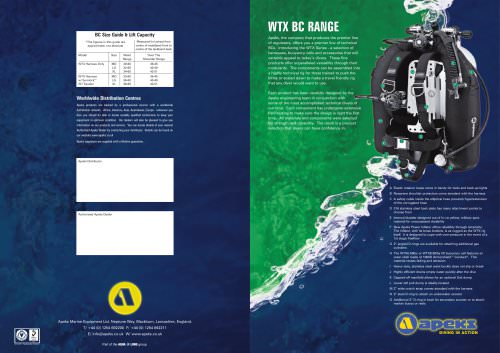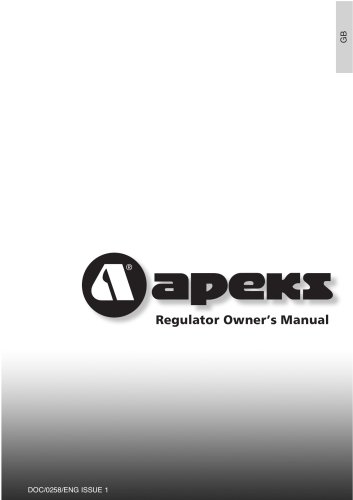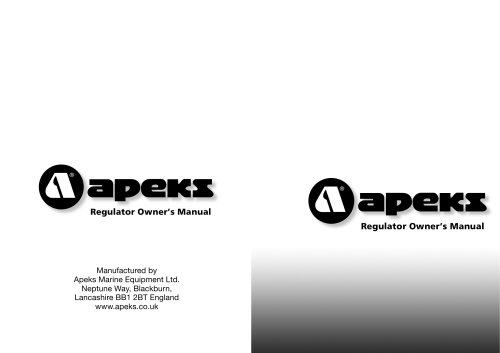
Catalog excerpts

Nitrox Dive Computer User's Guide
Open the catalog to page 1
Pulse Owner's Manual
Open the catalog to page 3
Pulse Owner's Manual All warnings and cautions are identified with the triangle symbol. Whenever you see a warning or a caution, read it carefully, as it may protect you from serious injury or damage to the product. Read the manual in its entirety before attempting to use the Pulse computer. AWARNING: Decompression sickness (aka, "the bends") is an inherent risk of SCUBA diving. Even if you properly follow all the instructions in this manual, and dive within the recreational limits of SCUBA diving, you still run the risk of getting decompression sickness, or some other inherent risk of...
Open the catalog to page 5
experts and backed by years of research and thousands of dives. How- ever, these algorithms cannot account for factors like dehydration, fa- tigue, obesity, or poor physical conditioning. Therefore, always leave a comfortable safety margin in respect to no-decompression time and ascent speed. The computer is designed to ASSIST you in making a dive, not to CONTROL your dive.
Open the catalog to page 6
Pulse Owner's Manual AWARNING: Using the Pulse will not prevent decompres- sion sickness, but using it sensibly reduces this risk. You must accept that there is no device or procedure that will totally prevent the possibility of a decompression
Open the catalog to page 7
Congratulations on the purchase of your new Pulse dive computer. As with all diving equipment, it is important to understand the features and functions of the Pulse. Before using the computer, read this manual in its entirety. Contained within this manual are illustrations Section 1 instructs you on how to navigate through the Pulse's surface modes. Section 2 describes all the underwater displays and functions while diving with the Pulse. Lastly, Section 3 covers care & mainte- This manual will clearly and concisely instruct you on the use of the Pulse. However, if you have any questions on...
Open the catalog to page 8
Pulse Owner's Manual Using the Pulse on the Surface
Open the catalog to page 9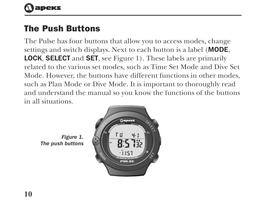
The Pulse has four buttons that allow you to access modes, change settings and switch displays. Next to each button is a label (MODE, LOCK, SELECT and SET, see Figure 1). These labels are primarily related to the various set modes, such as Time Set Mode and Dive Set Mode. However, the buttons have different functions in other modes, such as Plan Mode or Dive Mode. It is important to thoroughly read and understand the manual so you know the functions of the buttons
Open the catalog to page 10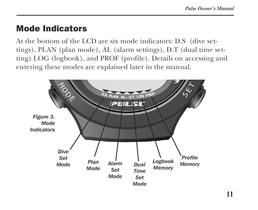
Pulse Owner's Manual Mode Indicators At the bottom of the LCD are six mode indicators: D.S (dive set- tings), PLAN (plan mode), AL (alarm settings), D.T (dual time set- ting) LOG (logbook), and PROF (profile). Details on accessing and entering these modes are explained later in the manual. Pla" Alarm Dual Lo&ook Memory
Open the catalog to page 11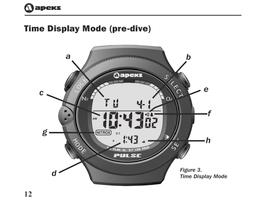
Time Display Mode (pre-dive) a b e c f g h d 12 Figure 3. Time Display Mode
Open the catalog to page 12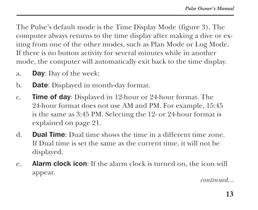
Pulse Owner's Manual The Pulse's default mode is the Time Display Mode (figure 3). The computer always returns to the time display after making a dive or ex- iting from one of the other modes, such as Plan Mode or Log Mode. If there is no button activity for several minutes while in another mode, the computer will automatically exit back to the time display. b. Date: Displayed in month-day format. c. Time of day: Displayed in 12-hour or 24-hour format. The 24-hour format does not use AM and PM. For example, 15:45 is the same as 3:45 PM. Selecting the 12- or 24-hour format is d. Dual Time:...
Open the catalog to page 13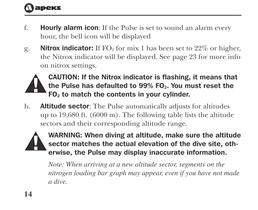
f. Hourly alarm icon: If the Pulse is set to sound an alarm every hour, the bell icon will be displayed g. Nitrox Indicator: If F02 for mix 1 has been set to 22% or higher, the Nitrox indicator will be displayed. See page 23 for more info ACAUTION: If the Nitrox Indicator Is flashing, It means that the Pulse has defaulted to 99% F02. You must reset the F02 to match the contents In your cylinder. h. Altitude sector: The Pulse automatically adjusts for altitudes up to 19,680 ft. (6000 m). The following table lists the altitude sectors and their corresponding altitude range. AWARNING: When...
Open the catalog to page 14
Pulse Owner's Manual Sector Altitude Range — àÀ.àkà Error. Icons flash above 19680 ft (6000 m)
Open the catalog to page 15
To activate the backlight, press SET. The backlight will stay on for 3 When the battery power is too low for the computer to function properly, the Pulse displays a battery icon (see figure 4). When the battery icon is blinking, you can place the computer into Transfer Mode to download your dive profiles to a PC, but it will not enter dive mode. When the battery icon stops blinking, you cannot dive with the computer and will not be able to transfer to a personal computer.
Open the catalog to page 16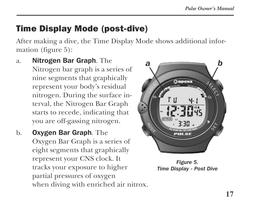
Pulse Owner's Manual Time Display Mode (post-dive) After making a dive, the Time Display Mode shows additional infor- Nitrogen bar graph is a series of nine segments that graphically represent your body's residual nitrogen. During the surface in- terval, the Nitrogen Bar Graph starts to recede, indicating that Oxygen Bar Graph is a series of eight segments that graphically represent your CNS clock. It tracks your exposure to higher partial pressures of oxygen when diving with enriched air nitrox. Time Display - Post Dive
Open the catalog to page 17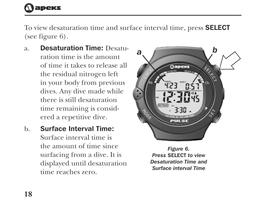
To view desaturation time and surface interval time, press SELECT a. Desaturation Time: Desatu- ration time is the amount of time it takes to release all the residual nitrogen left in your body from previous dives. Any dive made while there is still desaturation time remaining is consid- ered a repetitive dive. b. Surface Interval Time: Surface interval time is the amount of time since surfacing from a dive. It is displayed until desaturation time reaches zero. Press SELECT to view Surface interval Time
Open the catalog to page 18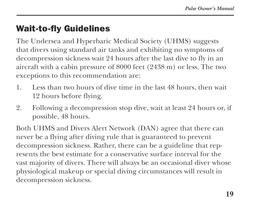
Pulse Owner's Manual Wait-to-fly Guidelines The Undersea and Hyperbaric Medical Society (UHMS) suggests that divers using standard air tanks and exhibiting no symptoms of decompression sickness wait 24 hours after the last dive to fly in an aircraft with a cabin pressure of 8000 feet (2438 m) or less. The two exceptions to this recommendation are: 1. Less than two hours of dive time in the last 48 hours, then wait 12 hours before flying. 2. Following a decompression stop dive, wait at least 24 hours or, if Both UHMS and Divers Alert Network (DAN) agree that there can never be a flying after...
Open the catalog to page 19All Apeks catalogs and brochures
-
Status Brochure
8 Pages
-
XTX_Brochure
8 Pages
-
WTX_Brochure
2 Pages
-
Flight Regulator Brochure
4 Pages
Archived catalogs
-
XTX Regulator Owner's Manual
32 Pages
-
Status Regulators Brochure
8 Pages
-
TX and ATX Regulators
16 Pages
-
Quantum Manual
56 Pages





